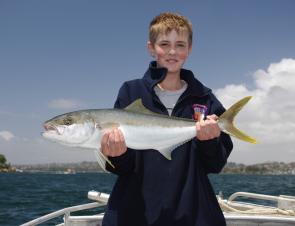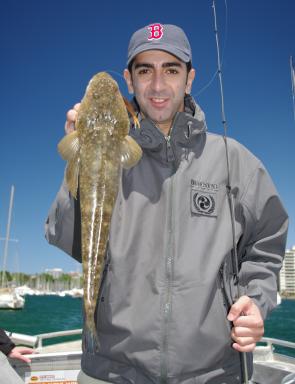Kingfish should be well and truly on the chew by now although don’t expect too many of the bigger fish until about mid-January.
Kings first show up in the Harbour around mid October and stay right through until May. They do have a little holiday, though, from about mid-December to mid-January, when they move back offshore to the close reefs for breeding.
You still get a lot of immature 1kg-4kg fish in the Harbor at this time. The good news is that when the big fellas come back in, they are usually really hungry.
December can also be a good month for school jewfish. You won’t find many of the really big specimens but 3kg-10kg fish school up around the deeper reefs in the lower Harbour. Shark Island, Neilson Park, Dobroyd Reef and Middle Head are good spots to start looking.
If you want to consistently catch jewies you must crack the formula down to every last detail. Unlike most other fish, you won’t get by just having half of it solved.
Kingfish, for example, have a high metabolism so they are hungrier more often than jewfish. This gives us the leeway of being able to get some parts of the kingie formula wrong – sometimes. In other words, you simply won’t get as many shots at jewies as you will at kings and therefore must work harder at filling the jewfish formula to achieve consistent results.
Here are a few starting points.
• Use big baits on the bottom, preferably fresh squid. Fresh means you caught it yourself.
• They are year-round fish so don’t neglect the Winter months but right now is a great time for school fish as they congregate in the lower reaches before making their way upstream. I think that the main reason that they move upstream through the main season is that the competition from kingies just gets too intense in the lower reaches.
• The week leading up to the new moon and the full moon are prime times. There are prime days within these weeks but you will have to work them out yourself. The week after the full moon is a waste of time.
• All of my biggest fish have been caught on slack water of the full tide but the last hour of the run up and the first hour of the run out are good times. Turn of the low is a reasonable second option
• They prefer major points, bends, holes and structure like bridge pylons and wrecks.
The flatties have fired up with the warm weather. They are well distributed from the uppermost reaches to the Heads. Around the heads is dominated by the smaller sand flathead commonly encountered offshore, with the occasional dusky especially when using larger live baits.
Upstream is the exclusive domain of the dusky which despite growing considerably larger is comfortable in as little as 30cm of water.
The skill, thrill and anticipation involved in hunting flatties on lures is little different from chasing any other predatory species including the tropical glamour fish. In the clearer water often found in the upper reaches of Middle Harbour and the Lane Cove River there's the added appeal of seeing the hooked fish in action.
Some of the best areas to lure fish for flatties include the shallows of Rose Bay, upper Middle Harbour, all of the Lane Cove River, Iron Cove and the Parramatta River from Gladesville bridge upstream.
Work these areas two hours before low tide and one hour after it starts to come in, especially if this occurs early morning or late afternoon.
Flathead congregate around channel edges, rock bars, weed banks and sandy/muddy drop-offs. Anywhere water is channelled off mangroves or flats on a falling tide is well worth a throw.
A single-handed spinning or light baitcasting outfit loaded with 3kg-4kg line will handle any flathead provided you use a more substantial trace of about 10kg.
Flathead will hit almost anything that swims past their faces. With the emphasis on presenting the lure close to the fish, depth capabilities are the major consideration when choosing a lure.
Considering you will be fishing depths from 50cm to 5m you'll need a large selection hardbodies but the more versatile and possibly more effective option is to carry two types of soft plastics.
For the shallows to 1.5m, a soft stickbait is deadly, especially around weed. To cover all depths it’s hard to go past a soft plastic on a jig head.
Flounder are welcome by-catch of flattie luring and generally favour the same areas, although they prefer the deeper sand banks. To target flounder, drop down in lure size to something around 50mm.
Reads: 3074
You get a lot of immature 1kg-4kg fish in the Harbor this month but the good news is that when the big fellas come back in, they are usually really hungry.

Right now is a great time for school jewfish as they congregate in the lower reaches before making their way upstream.

Upstream is the exclusive domain of the dusky which despite growing considerably larger is comfortable in as little as 30cm of water.




